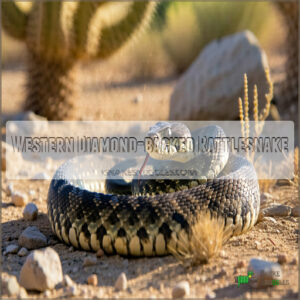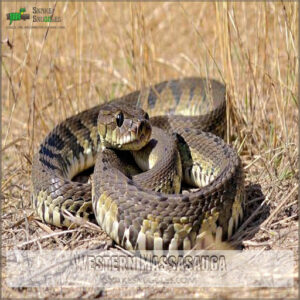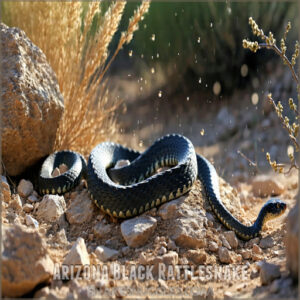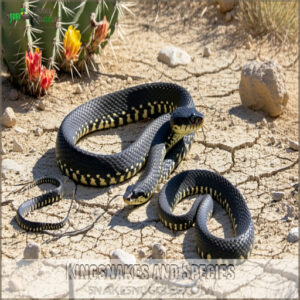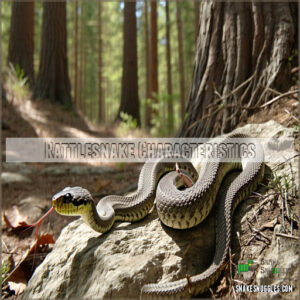This site is supported by our readers. We may earn a commission, at no cost to you, if you purchase through links.

While rattlers might steal the spotlight with their warning signals and heat-sensing pits, plenty of non-venomous snakes call the Land of Enchantment home too.
These serpentine neighbors hang out in diverse spots – from sun-baked desert flats to cool mountain streams.
Most are actually pretty chill creatures who’d rather slither away than cause trouble.
Knowing which snakes are your friends and which deserve extra space can make all the difference in your outdoor adventures.
Table Of Contents
- Key Takeaways
- Venomous Snakes Found
- Non-Venomous Snake Types
- Kingsnakes and Species
- Snake Identification Tips
- New Mexico Snake Habitats
- Frequently Asked Questions (FAQs)
- Are there snakes in New Mexico?
- Are there blind snakes in New Mexico?
- How many venomous snakes are there in New Mexico?
- What do venomous snakes look like in New Mexico?
- How can I identify a snake in New Mexico?
- Are snakes dangerous in New Mexico?
- What venomous snakes are in New Mexico?
- Are snakes a problem in New Mexico?
- How can I identify a type of snake?
- What kind of snake kills rattlesnakes?
- Conclusion
Key Takeaways
- You’ll find 46 snake species in New Mexico, including 11 venomous species (10 rattlesnakes and 1 coral snake), with the Western Diamond-backed Rattlesnake being the most well-known.
- You can identify venomous snakes by their thick, triangular heads, heat-sensing pits behind their eyes, and rattles, while non-venomous snakes have slender heads and round pupils.
- You’ll encounter different snake species across various habitats – from desert flats and rocky outcrops to grasslands and water bodies – with each species adapted to its specific environment.
- You’re unlikely to face snake problems if you take basic precautions: wear closed shoes, keep your distance, and remember that snakes typically avoid human contact unless they feel threatened.
Venomous Snakes Found
New Mexico is home to some fascinating venomous snakes, including rattlesnakes with their iconic rattles and venom that helps them hunt.
Don’t worry, though—they mostly want to be left alone and won’t bother you unless they feel threatened!
Western Diamond-backed Rattlesnake
The Western Diamond-backed Rattlesnake, one of New Mexico’s venomous snakes, thrives in desert habitats.
Its distinct diamond patterns and telltale rattle make snake identification easier. These rattlesnakes rely on venom to ambush prey like rodents and birds.
Many other New Mexico snake species also inhabit the state. If threatened, they’ll rattle—a polite warning to back off.
Rattlesnake bites are rare but dangerous; always seek medical help immediately!
Prairie Rattlesnake
The Prairie Rattlesnake is a master of camouflage in New Mexico’s prairie habitat.
With greenish-gray or yellow-brown skin, it blends perfectly into the grasslands.
These venomous snakes use snake venom to hunt rodents and birds.
New Mexico also has non-venomous kingsnakes.
Known for rattlesnake behavior like hibernating in communal dens, they’re essential for rattlesnake conservation.
Remember, give these rattlesnakes space—they’re not looking for trouble!
Western Massasauga
Unlike its larger rattlesnake cousins, the Western Massasauga’s modest size and secretive nature set it apart.
It thrives in New Mexico’s grassy habitats despite habitat loss and conservation concerns.
Interested parties can find Western Massasauga related products.
You’ll spot its subtle, brown blotches in:
- Open grasslands with sandy areas
- Snake dens during colder months
- Quiet hiding spots under debris
- Prey-rich zones filled with rodents
Arizona Black Rattlesnake
The Arizona Black Rattlesnake is a shy venomous snake in New Mexico’s desert habitats.
It’s dark with unique patterns that shift as it grows.
You can find Arizona black rattlesnake products.
This rattlesnake’s venom isn’t overly aggressive but still dangerous, causing pain and swelling in snake bites.
They prefer to avoid conflict, showing typical rattlesnake behavior like coiling and rattling.
Be cautious around them!
Rock Rattlesnake
The Rock Rattlesnake, a smaller cousin of the Western Diamondbacked Rattlesnake, loves rocky habitats in New Mexico.
It’s a master of camouflage with muted gray or pinkish tones that blend perfectly into desert landscapes.
You can find rock rattlesnake New Mexico products.
Like other rattlesnakes in New Mexico, its venom helps with desert survival, and if you hear its rattle sound, give it space—this shy snake prefers to avoid conflict.
Non-Venomous Snake Types
You’ll find plenty of non-venomous snakes in New Mexico, and most are harmless to people.
From the speedy Black Racer to the water-loving Plain-bellied Watersnake, these snakes play a big role in keeping ecosystems healthy.
Plain-bellied Watersnake
Switching from rattlers to swimmers, the Plain-bellied Watersnake thrives in water habitats and adds charm to New Mexico herpetology.
These non-venomous snakes exhibit diverse coloration and patterns.
This non-venomous snake has unique aquatic adaptations and feeds on diverse prey.
- Coloring: Solid tops with plain red to yellow bellies.
- Diet: Prefers frogs, fish, and small amphibians.
- Length: Reaches 2-3 feet, making it easy to spot!
Western Ribbon Snake
The Western Ribbon Snake is a semi-aquatic marvel among New Mexico snakes.
It thrives in water habitats, flaunting vibrant ribbon patterns of black, brown, or olive with light stripes.
This snake species in NM uses clever head thrusts to snatch prey, including fish and amphibians.
Its diet fits perfectly into its environment, showcasing nature’s precision, and is both practical and pretty, right?
Glossy Snake
With a sleek tan body and brown blotches, the Glossy Snake blends right into New Mexico’s desert ecology.
Nocturnal behavior means you’ll rarely see this snake species in the daytime. Its diet includes lizards, birds, and rodents.
Looking for one? Check:
- Sandy or rocky snake habitats.
- Warm desert areas.
- Spots with plenty of hiding spaces.
Black Racer
The Black Racer, or Coluber constrictor constrictor, isn’t your typical neighbor among New Mexico snakes.
Known for its lightning “snake speed”, this agile reptile zips through grasslands hunting its favorite meal—small rodents and insects.
Surprisingly, it’s not a fan of tank life as a pet. Keep space between you and this quick, glossy snake—it’s fast, not friendly!
| Feature | Details |
|---|---|
| Color | Solid black, white chin |
| Size | 33-65 inches long |
| Behavior | Fast, defensive, solitary |
Bullsnake
Bullsnakes, one of the largest non-venomous snakes in New Mexico, can reach up to six feet.
Often mistaken for rattlesnakes, these harmless snakes help control rodents.
They thrive in grasslands and deserts, key to New Mexico’s ecology.
Bullsnake behavior includes loud hissing and tail vibrating, mimicking venomous species.
Appreciating these gopher snakes supports desert conservation efforts.
Kingsnakes and Species
You’d probably recognize a kingsnake by its bold patterns and shiny scales.
But did you know they’re immune to rattlesnake venom? These non-venomous hunters, like the California Kingsnake and Desert Kingsnake, are nature’s pest control.
They are even eating other snakes!
Speckled Kingsnake
The Speckled Kingsnake, a stunning snake species in NM, stands out with its shiny black body dappled with yellow spots.
It thrives in diverse Kingsnake habitats like grasslands and marshes.
Their diet is fascinating—1. rodents, 2. birds, and 3. even venomous snakes!
Thanks to their strong immunity, they’re snake conservation heroes, playing an essential role in keeping ecosystems balanced.
California Kingsnake
California Kingsnakes are true crowd-pleasers among New Mexico snakes.
Boldly patterned in black and white bands, they live in a variety of habitats, from deserts to forests.
Known for their gentle behavior, they rarely bite and make popular pet kingsnakes.
Their diet includes rodents, lizards, and even other snakes, making them versatile kingsnakes and a natural wonder.
These kingsnakes are helpful predators.
Sonoran Mountain Kingsnake
The Sonoran Mountain Kingsnake is a master of disguise with its vivid red, black, and white bands, offering excellent snake camouflage in rocky, mountain habitats.
Found among New Mexico snakes, these kingsnakes are non-venomous and dine on rodents, reptiles, and eggs—an impressive kingsnake diet.
They’re known for their docile nature and easy handling, which highlights their docile nature.
Calm and shy, their behavior highlights the importance of snake conservation for these essential predators, making them a great example of why conservation efforts are necessary.
Desert Kingsnake
Among New Mexico’s most fascinating reptiles, you’ll find the Desert Kingsnake thriving in our state’s diverse landscapes.
These adaptable snakes love making their homes in rocky outcrops and desert flats, where they help maintain the local ecosystem by hunting other snakes.
You’ll spot them by their distinctive black and white bands, which serve as a warning to predators. They’re non-venomous and actually help control rattlesnake populations by hunting them, which is a key role in the ecosystem as Desert Kingsnake.
Gray-banded Kingsnake
You’ll love spotting the Gray-banded Kingsnake with its stunning bands of gray, orange, and black wrapping around its body.
This beautiful reptile thrives in New Mexico’s rocky outcrops and desert flats, making it a fascinating find for wildlife enthusiasts.
- Perfectly adapted to hunt at night, catching small rodents and lizards
- Known for their gentle nature and remarkable climbing abilities
- Can grow up to 3-4 feet long, though they’re rarely seen due to secretive habits
Snake Identification Tips
You’ll find it’s not too tricky to tell New Mexico’s snakes apart once you know what to look for, especially the rattler’s distinctive features like their thick heads and heat-sensing pits.
Whether you’re hiking through the desert or working in your garden, you’ll want to remember these simple tips that’ll help you spot the difference between our state’s venomous and non-venomous serpent friends, using these simple tips to identify them.
Rattlesnake Characteristics
While kingsnakes display beautiful patterns, rattlesnakes pack some seriously distinctive features you’ll want to know about.
You’ll spot their trademark rattle at the tail’s tip, which makes that famous warning sound.
They’ve got thick, blocky heads with special heat-sensing pits behind their eyes – nature’s thermal cameras!
Look for vertical, cat-like pupils and those unmistakable venom glands that give their heads that wide, angular shape.
Non-Venomous Snake Lookalikes
While rattlesnakes might be the stars of New Mexico’s snake show, several harmless snakes pull off quite the impersonation act. Many non-venomous snakes exhibit diverse coloration and patterns. You’ll be surprised how many nonvenomous snakes can mimic their dangerous cousins!
Here’s how to spot these clever snake impostors:
- Gopher snakes flatten their heads and hiss loudly
- Bullsnakes vibrate their tails against dry leaves
- King snakes sport similar band patterns
- Milk snakes copy coral snake colors
- Western ribbon snakes display diamond-like markings
Don’t worry too much – these copycats are just trying to stay safe!
Snake Behavior and Habitat
Three key factors drive snake behavior in New Mexico: temperature, food, and shelter.
You’ll often spot these fascinating creatures basking on warm roads or hiding in cool, dark spaces.
Here’s a quick guide to understanding snake habits:
| Behavior | Location | Time of Day |
|---|---|---|
| Basking | Roads, Rocks | Morning |
| Hunting | Gardens, Fields | Dawn/Dusk |
| Resting | Burrows, Logs | Afternoon |
| Breeding | Open Areas | Spring |
These cold-blooded creatures maintain their body heat by moving between sunny and shaded spots, just like natural temperature dancers, exhibiting unique behavior in their natural habitats.
Safety Precautions
While snakes play an essential role in nature, staying safe is simple – just keep your distance.
You’ll be glad to know these slithering neighbors aren’t looking for trouble, they’ll typically move along if left alone.
When outdoors, protect yourself by wearing closed shoes and long pants, and teach your kids to spot local venomous species.
Remember: snakes only strike when they feel threatened, so it’s crucial to respect their space and let them be.
Skip those pricey snake deterrents – they don’t work in open areas.
New Mexico Snake Habitats
You’ll find New Mexico’s snakes making themselves at home in all sorts of places, from sandy desert flats and rocky mountain slopes to grassy prairies and even your backyard.
Whether you’re hiking through brushy terrain or spotting a water snake near a stream, you’re likely to encounter these fascinating reptiles across the state’s diverse landscapes.
Desert Flats and Rocky Outcrops
Now that you know how to spot different snake species, let’s explore where they hang out.
Desert flats and rocky outcrops in New Mexico are like nature’s snake hotels! You’ll find Northern Trans-Pecos Rat Snakes basking on sun-warmed rocks, while Western Diamond-backed Rattlesnakes prefer hiding in rocky crevices.
These arid landscapes provide perfect spots for snake denning, especially in winter when they need shelter from extreme temperatures.
Grasslands and Brushy Slopes
Out in the sprawling grasslands of New Mexico, you’ll spot plenty of snakes making their home among the brushy slopes.
The Western Massasauga loves these grassy spots, while kingsnakes and bullsnakes thrive in the dense brush.
You’re likely to find garter snakes basking on sun-warmed rocks, maintaining the delicate ecosystem balance.
These areas offer perfect hunting grounds and shelter, supporting New Mexico’s diverse snake population.
Aquatic and Terrestrial Environments
Beyond the sweeping grasslands, New Mexico’s aquatic and terrestrial environments create perfect homes for diverse snake species.
You’ll find Western Ribbon Snakes gracefully swimming near water bodies, while Plain-bellied Watersnakes hunt both in and out of streams.
In drier areas, Desert Ecology shapes snake behavior differently – these remarkable creatures migrate between wet and dry zones as seasons change, maintaining nature’s delicate ecosystem balance and showcasing their ability to adapt to various environments, ultimately contributing to the preservation of nature’s harmony.
Common Snake Habitats Around Homes
Have you ever wondered why snakes seem drawn to your property?
You’ll often spot these reptiles around homes in New Mexico, especially near wood piles, dense shrubs, and rock gardens.
Snakes utilize diverse North American habitats.
They’re attracted to places that offer both shelter and food – like those cozy spots under your porch where mice like to hide.
By understanding these preferred hangouts, you’ll better manage your backyard’s snake activity.
Frequently Asked Questions (FAQs)
Are there snakes in New Mexico?
Like stars scattered across the desert sky, you’ll find 46 different snake species slithering through New Mexico’s diverse landscapes.
From rattlers to racers, they’re your wild neighbors in the Land of Enchantment.
Are there blind snakes in New Mexico?
You’ll find two types of blind snakes in New Mexico: the Western Blind Snake and New Mexico Blind Snake. They’re small, worm-like creatures that spend most of their time underground.
How many venomous snakes are there in New Mexico?
You’ll find 11 venomous snake species in New Mexico, with 10 being rattlesnakes! The final member of this dangerous family is the coral snake. Always watch your step when hiking here.
What do venomous snakes look like in New Mexico?
You’ll spot venomous snakes by their thick, blocky heads with heat-sensing pits behind their eyes.
Most have diamond-shaped blotches and rattles, while their colors range from brown to gray or reddish.
How can I identify a snake in New Mexico?
You’ll know it’s venomous if you see a rattle, thick head, or heat-sensing pits behind the eyes.
Non-venomous snakes have slender heads and round pupils.
When in doubt, keep your distance.
Are snakes dangerous in New Mexico?
Imagine this: You’re hiking through New Mexico’s desert trails.
While most snakes won’t chase you, 11 venomous species call this state home.
Stay alert, give them space, and you’ll both peacefully coexist.
What venomous snakes are in New Mexico?
You’ll encounter 11 venomous snake species in New Mexico, including 10 rattlesnakes like the Western Diamond-backed and Prairie Rattler. There’s also one coral snake species slithering through the state’s diverse landscape.
Are snakes a problem in New Mexico?
Like desert guardians, snakes in New Mexico rarely cause trouble if you’re careful.
You’ll find them mostly keeping to themselves, but it’s smart to watch your step and keep your distance when hiking.
How can I identify a type of snake?
Check for a rattle first – it’s your biggest clue.
Look at the head shape (triangular means venomous), check for heat-sensing pits behind the eyes, and notice the body patterns and markings.
What kind of snake kills rattlesnakes?
Did you know kingsnakes are nature’s ninja warriors?
You’ll find these natural predators hunting and killing rattlesnakes, thanks to their immunity to venom.
They’ll wrap around their prey and squeeze tight before eating.
Conclusion
Like a diverse tapestry woven across New Mexico’s landscapes, the types of snakes in New Mexico create a fascinating natural mosaic.
You’ll spot everything from rattlers basking on sun-warmed rocks to kingsnakes gliding through desert brush.
While it’s smart to keep your distance from venomous species, remember most snakes would rather avoid you.
Armed with this knowledge, you’re ready to safely explore alongside these remarkable reptiles that call the Land of Enchantment home.

